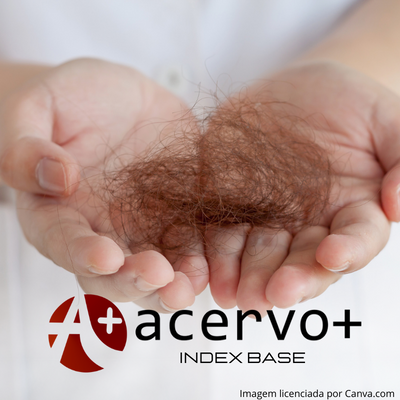Eflúvio Telógeno pós-COVID: uma revisão integrativa
##plugins.themes.bootstrap3.article.main##
Resumo
Objetivo: Avaliar os principais fatores relacionados ao Eflúvio telógeno pós-COVID. Métodos: Nessa Revisão Integrativa, os artigos foram selecionados nos bancos de dados Science Direct, Portal Capes e U. S. National Library of Medicine (PubMed). Os descritores de busca foram: “Telogen Effluvium”, “COVID-19” e “Data Collection”, articulados com o operador booleano “AND”. Com a adoção de artigos publicados entre os anos de 2020 e 2022, na língua inglesa, recurso online e acesso aberto e exclusão dos duplicados nas bases de dados escolhidas e dos que não apresentaram respostas à pergunta base para a pesquisa, restaram 17 artigos. Resultados: A COVID-19 influencia na queda capilar após a infecção a partir de alguns fatores, como: fatores imunes, que englobam a elevação de citocinas pró-inflamatórias, a reação microtrombótica nos folículos pilosos, a reação medicamentosa e a deposição de imunocomplexos. Além de fatores psíquicos, como estresse e ansiedade. Considerações finais: Portanto, a infecção pelo coronavírus tem relação direta com a queda capilar, independente do fator envolvido, sendo importante haver familiarização e preparação dos profissionais sobre o assunto.
##plugins.themes.bootstrap3.article.details##
Copyright © | Todos os direitos reservados.
A revista detém os direitos autorais exclusivos de publicação deste artigo nos termos da lei 9610/98.
Reprodução parcial
É livre o uso de partes do texto, figuras e questionário do artigo, sendo obrigatória a citação dos autores e revista.
Reprodução total
É expressamente proibida, devendo ser autorizada pela revista.
Referências
2. BABAEI K, et al. Characteristics of telogen effluvium in COVID-19 in western Iran. Anais Brasileiros de Dermatologia, 2021; 96(6).
3. CLINE A, et al. A surge in the incidence of telogen effluvium in minority predominant communities heavily impacted by COVID-19. J Am Acad Dermatol, 2021a; 84(3) :773-775.
4. CLINE A, et al. Race, ethnicity, and comorbidities are critical factors in the diagnosis of telogen effluvium during the COVID-19 pandemic. Journal of the American Academy of Dermatology, 2021b; 85(1): 209-211.
5. FERNÁNDEZ-LÁZARO D, GARROSA M. Identification, Mechanism, and Treatment of Skin Lesions in COVID-19: A Review. Viruses, 2021; 13(10).
6. GARCES SBB. Classificação e tipos de pesquisas. Universidade de Cruz Alta–Unicruz, 2010.
7. GENTILE P. Hair Loss and Telogen Effluvium Related to COVID-19: The Potential Implication of Adipose-Derived Mesenchymal Stem Cells and Platelet-Rich Plasma as Regenerative Strategies. International Journal of Molecular Sciences, 2022; 23(6).
8. HAN J, et al. Correlation Between Interest in COVID-19 Hair Loss and COVID-19 Surges: Analysis of Google Trends. JMIR Dermatology, 2022; 5(2).
9. LARIJANI MS, et al. Characterization of long COVID-19 manifestations and its associated factors: A prospective cohort study from Iran. Microbial Pathogenesis, 2022; 169.
10. LIMA PCQMC, BRANDÃO BJF. Eflúvio Telógeno Agudo e Alopecia Areata Associada a COVID-19. BWS Journal, 2022; 5.
11. LV S, et al. A Case of Acute Telogen Effluvium After SARS-CoV-2 Infection. Clinical, Cosmetic and Investigational Dermatology, 2021; 14: 385-87.
12. MONARI P, et al. Post-SARS-CoV-2 Acute Telogen Effluvium: An Expected Complication. Journal of Clinical Medicine, 2022; 11(5): 1234.
13. MÜLLER-RAMOS P, et al. Post-COVID-19 hair loss: prevalence and associated factors among 5,891 patients. International journal of dermatology, 2022; 61(5): 162–164.
14. NALBANDIAN A, et al. Post-acute COVID-19 syndrome. Nature Medicine, 2021; 27: 601–615.
15. NATÁRIO JAA, et al. A queda capilar pode ser considerada uma das consequências da COVID-19? Research, Society and Development, 2022; 11(1).
16. OLIVEIRA IM, BRANDÃO BJF. Tratamento do Eflúvio Telógeno Pós-Covid. BWS Journal, 2021; 4:1-8.
17. PEGHIN M, et al. Post–COVID-19 syndrome and humoral response association after 1 year in vaccinated and unvaccinated patients. Clinical Microbiology and Infection, 2022; 28(8): 1140-1148.
18. PROAL AD, VANELZAKKER MB. Long COVID or Post-acute Sequelae of COVID-19 (PASC): An Overview of Biological Factors That May Contribute to Persistent Symptoms. Frontiers in microbiology, 2021; 12.
19. QAMAR MA, et al. Residual symptoms and the quality of life in individuals recovered from COVID-19 infection: A survey from Pakistan. Annals of Medicine and Surgery, 2022; 75.
20. RECALCATI S, et al. COVID-19: The experience from Italy. Clinics in Dermatology, 2021; 39(1):12-22.
21. RODA A., SOARES RO. Acute Telogen Effluvium in Patients Recently Infected with SARS-CoV-2. Revista Da Sociedade Portuguesa De Dermatologia E Venereologia, 2021; 79(1): 21-25.
22. SAKI N, et al. Intermittent Chronic Telogen Effluvium with an Unusual Dermoscopic Finding following COVID‐19. Clinical Case Reports, 2022; 10(8).
23. SEQUE CA. et al. Skin manifestations associated with COVID-19. Anais Brasileiros de Dermatologia, 2022; 97(1): 75-88.
24. SEYFI S, et al. Prevalence of telogen effluvium hair loss in COVID-19 patients and its relationship with disease severity. Journal of medicine and life, 2022; 15(5): 631-634.
25. SOUZA MT, et al. Revisão integrativa: o que é e como fazer. Einstein, 2010; 8(1): 102-6.
26. STARACE M, et al. Trichodynia and telogen effluvium in COVID-19 patients: Results of an international expert opinion survey on diagnosis and management. JAAD International, 2021; 5: 11–18.
27. TURKMEN D, et al. Evaluation of the effects of COVID-19 pandemic on hair diseases through a web-based questionnaire. Dermatologic therapy, 2020; 33(6).

